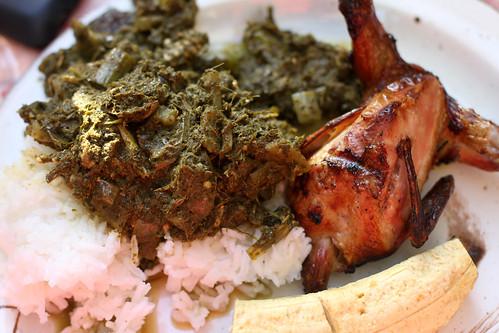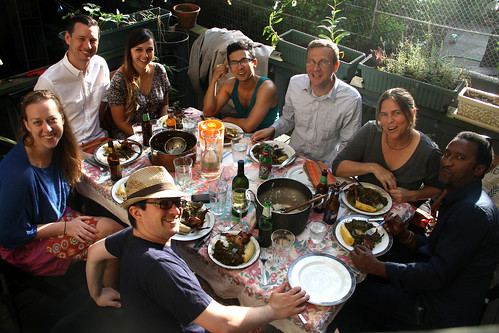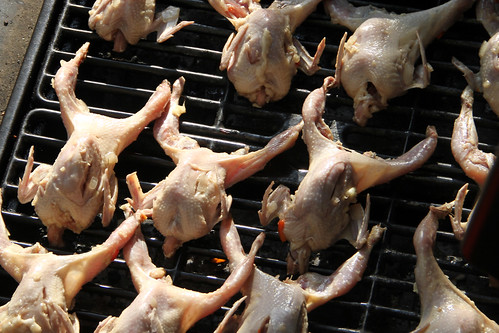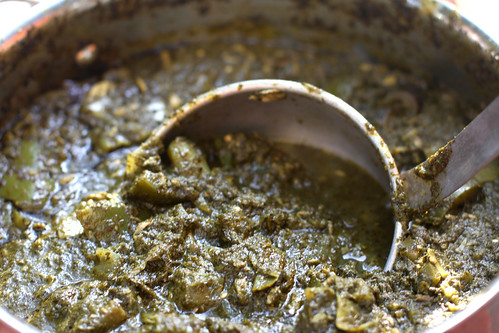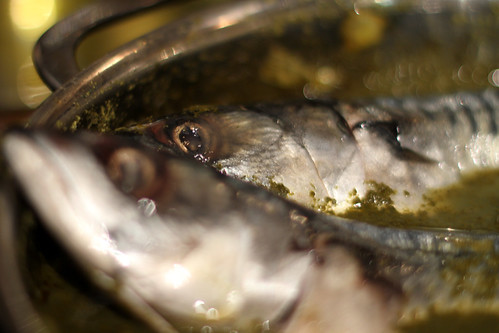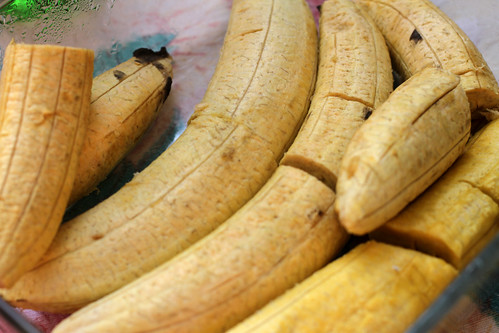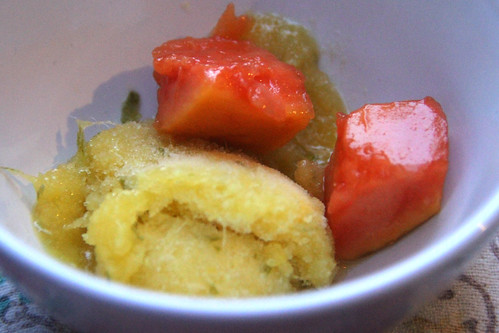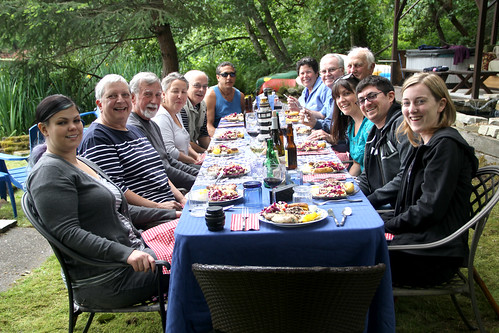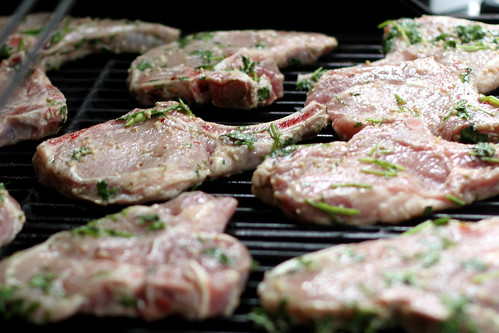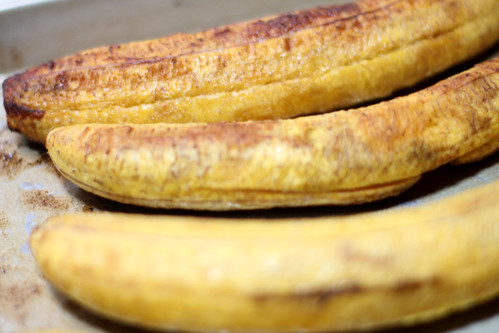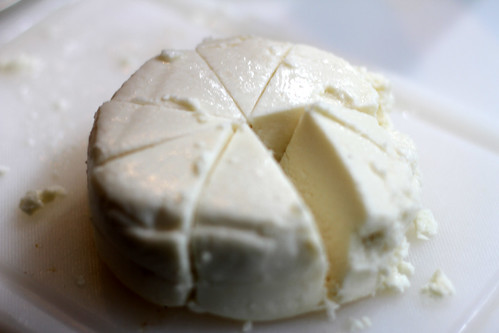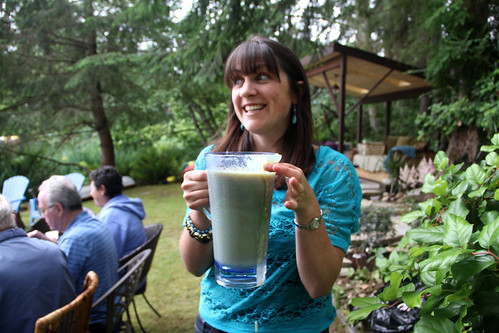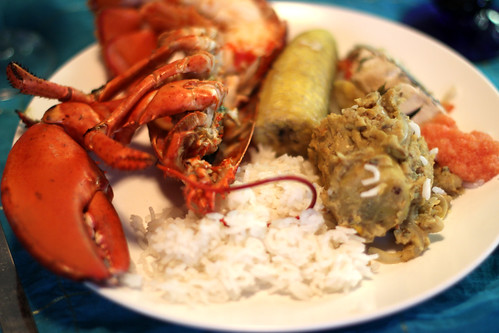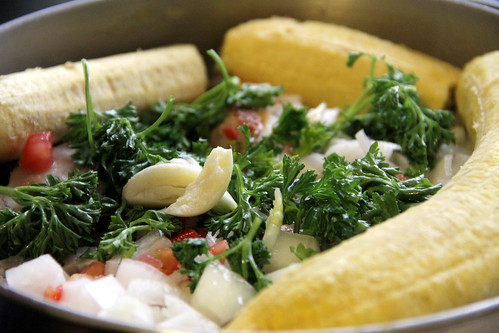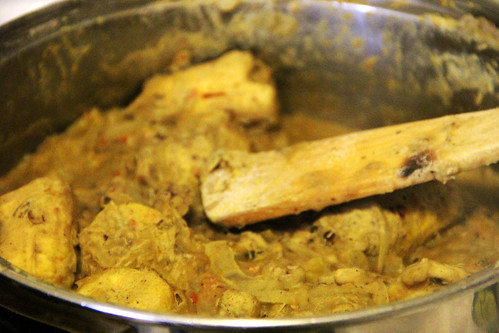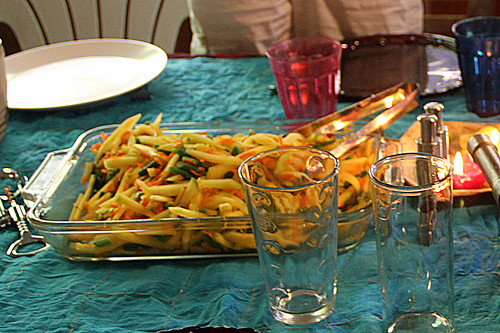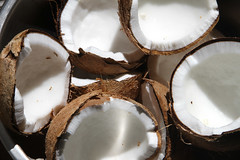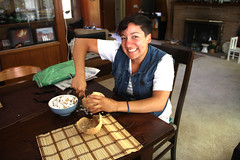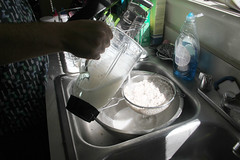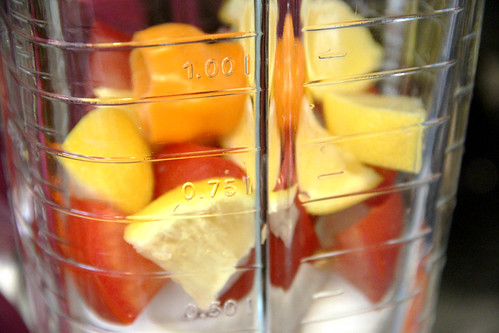Thanks to its unique location, Croatia straddles several opposing forces of history and geography, and of course this is reflected in the food. It features a unique shape, a comically long and thin Mediterranean coastline with a big bulb at the north stretching inland toward the heart of the Balkans. Parts or all of it have been subject in turn to Venetian, Ottoman and Austro-Hungarian empires, which have lent such influences as pasta, lamb, and strudel. And of course it's a matter of geography, with the Adriatic providing for seafood, citrus, olives and other Mediterranean abundance, and the inland favoring heartier, roasted affairs. And through it all, the Croatians have very much enjoyed their drink, taking advantage of abundant fruit-growing climates to make marvelous wines and all manner of brandies.
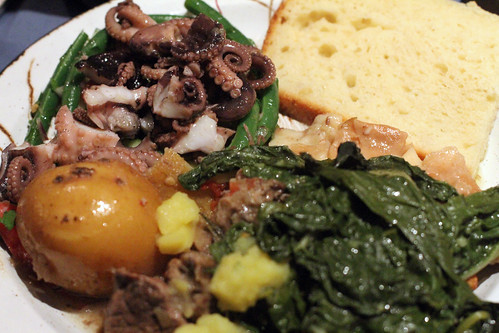
To craft this meal I had excellent guidance from Janet, the wife of a longtime family friend, who maintains strong connections to her relatives in Croatia. If I'd followed all her recommendations I'd have made a meal for fifty, so I picked and chose and still ended up spending all day in the kitchen! Frankly, without her I'd have been kinda lost and throwing darts at a cuisine that at first glance feels a bit random, and plus it's always a pleasure to learn about (and recreate!) family traditions. Thanks also to Zack, a friend of frequent nosher Caro, whose thoughts from several years of living there helped me clarify things.
Since a storm was blowing through we had to eat indoors, which was more than a bit warm what with the oven running pretty much all afternoon and evening. (Too bad 'cause it would have been fun to make the lamb in a "bell" on the barbecue as suggested.) Our guests were Colin, Kirsty, Sophie, Luisa, Christen, Sam, and Eleanor.
Pršut, Paški sir i masline | Prosciutto, Pag cheese and olives
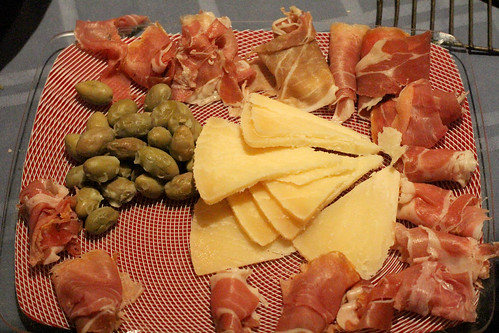
I love how when words jump between languages, they tend to conform to the familiar sounds and patterns of the tongues of those who pronounce them. Never one to pass up an opportunity to explore a culinary angle, I wrote a paper for phonology class in college called "Holy Guacamole" about American English pronunciation of Mexican Spanish food names. Well, the morphing of the Italian prosciutto into the Croatian pršut is a textbook example: just as the word comes roughly from the Latin for "that which has had the moisture expunged," so have the Croatians compressed things by halving the number of letters and removing a syllable. Perhaps if I ever tackle the same topic again, I'll name the paper "In Pršut of Happiness."
Anyway. Along with the lovely slices of dry-cured ham, we nibbled on olives, but the star of this appetizer show was truly the cheese. Paški sir comes from the isle of Pag, where a salty dry wind stunts the growth of all but the hardiest of little shrubs, and the sheep that nibble on them make some sort of awesome milk that becomes this excellent cheese. Its texture is somewhere between aged cheddar and parmesan, and the flavor is delightfully rich. It ain't cheap, but if you see it at your cheesemonger it's a worthwhile indulgence.
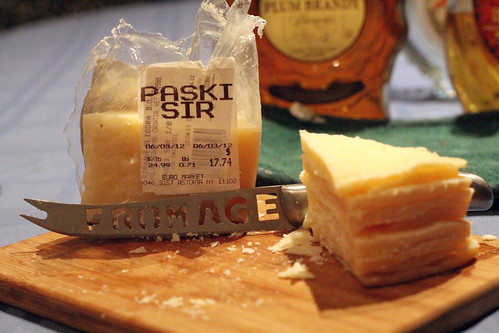
Pogača | Rich hearth bread | Recipe
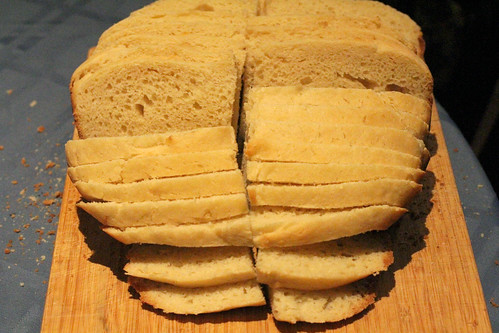
This is the first bread I've ever made that a friend has offered to pay me to bake again, so you don't have to take my word that it turned out fantastically. It's a pretty rich one, with milk, sour cream, butter, and egg, all baked in a dutch oven. The soft sweetness was a great foil for the salty and dense appetizers. If we had any left I'd love to try making French toast or bread pudding with it, but alas, it's all gone. (Note that if you make it, the dough will be rather goopy when you're done mixing. Resist the urge to add more flour, 'cause it turned out great.)
Vino i rakije | Wine and brandies
"How do you say cheers?" "Živeli!" "Do we sip it?" "No, take the whole shot!" And with that short conversation, we learned the basics of Croatian drinking from Christen, who's spent some time there. Unfortunately we couldn't find the travarica herbal liqueur that Janet recommended. However, we had plenty of brandy on hand from our cascading drinking around the Balkans: the šljivovica (plum) and rakija (grape) brandies were left over from the Bosnian meal, and we bought some extra šljivovica from Czech Republic anticipating (correctly) that we'd have some left over for that upcoming meal. We also enjoyed plenty of Croatian wines; the white mixed with seltzer to make what's known as gemist, while we enjoyed the red on its own — turns out that the main grape of Croatia is almost identical to Zinfandel!
Pečena janjetina | Roast lamb | Recipe
The recipe calls for cooking this dish under a bell-like lid that holds coals, but I just didn't have one of those, although Janet suggested we could use a terra cotta pot. But since it was storming, I went the easier way, re-using the dutch oven from the bread and cooking the lamb. The pot wasn't big enough for the whole leg so I cut it into pieces, and with it added potatoes, tomatoes, apples, onions, rosemary, and wine. I mighta overcooked it a bit, but it was sure tasty.
Mlinci |(what I call) Brothcrackers | Recipe
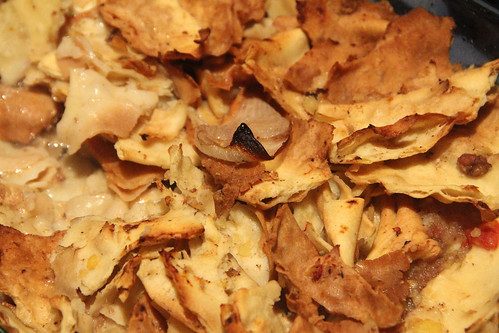
Why you don't see this genius dish in more cuisines is beyond me. It's so simple, cheap, efficient, and tasty. You make dough from flour, water and a little bit of egg, roll it out, bake it into crackers, soak it in a bit of water, and then bake it in the juices from whatever meat you just cooked. It's kind of like the tastiest napkin imaginable. Heck, I could even see scrambling up the leftovers with eggs like matzo brei or migas. Mmm.
Salata od hobotnice | Octopus salad | Recipe

There were very clear pro- and anti-octopus factions at the table, so rather than mix these adorable/horrifying creatures straight into the salad, we made it separate and guests were free to add the octopus if they wished. The recipe does call for big rather than baby, but this is what the fishmonger in Astoria had so I rolled with it. Probably took about an hour and a half of simmering, which is less than a big thick guy would have taken. I love the taste and texture, you may not.
Blitva | Chard and potatoes | Recipe
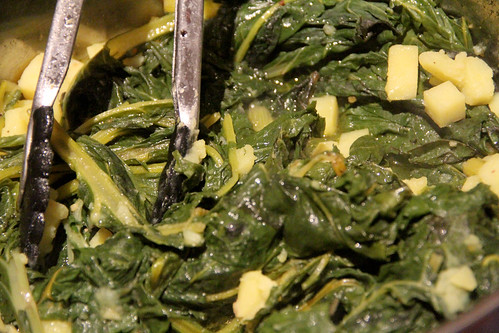
Simple, tasty, healthy. Really nothing more than potatoes and chard boiled in seasoned water and drizzled with quality olive oil. Especially tasty with veggies straight from the farmer's market. Will probably make again!
Štrudla s jabukama | Apple strudel | Recipe at end
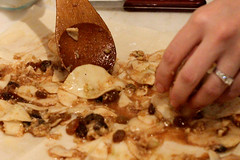
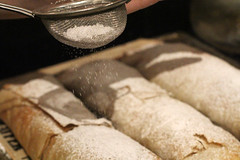
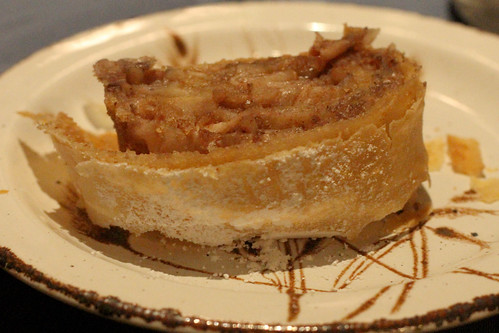
Macerated cherries
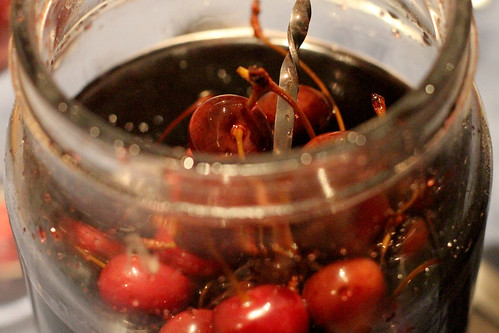
This is, quite literally, the cherry on top, where it all comes full circle. In the reversal of naming of the ham, it turns out that what we know as the maraschino cherry, by way of Italian, actually comes from Croatia, where it's called maraska and is actually a small sour cherry. Today's fake sugary red confection is a far cry from the original, which was steeped in liquor. Well, I couldn't find sour cherries easily, but I did get my hands on a few pounds of Bings and a bottle of kirschwasser cherry liqueur. I pretty much just mixed the two, plus well over a cup of sugar, shook it daily for the first few days, and waited. After a week it wasn't great, but two more weeks and wowza. Sweet enough for dessert, subtle enough to merit eating many, and definitely boozy enough to be fun! If you enjoy making cocktails, I recommend you macerate some cherries of your own.
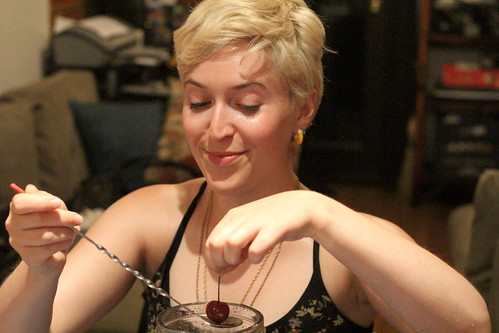
We enjoyed the meal to the surprisingly diverse sounds of Croatian music, from traditional ballads to hip-hop to straight up punk pop. And with that, we're taking a wee break from the pattern, and next week we've got a bit of an Olympic surprise!
Photos by Laura Hadden, who broke her rule of openmindedness and refused to try the octopus.
-----
Apple Strudel Recipe from Janet Garvin
This recipe is one of our family’s most highly treasured, since it was made often by my grandmother. Strudel displays the influence of the Austrian Empire on Croatia. Traditionally, the dough for this strudel is homemade—an eggy, elastic dough that is gradually stretched out on top of a white tablecloth until it covers the entire surface of a dining table about four feet across, and is translucent. This takes time. I did it once with my mother, and the results were worth it. On every other occasion I have made strudel, however, I have used packaged filo dough, which works well. This is my grandmother’s recipe, and the results are light, flavorful, exquisite when served at room temperature:
1 lb. filo dough 4 cups thinly sliced apples—my mom wrote in her copy of the recipe that you can use almost any kind—she recommends Granny Smith 1 cup sugar ½ cup raising—I like golden ½ cup toasted bread crumbs 1 tsp. cinnamon ½ tsp. nutmeg lemon zest—as much as you like (it is a very good addition) 1 cup of chopped almonds or walnuts—we prefer walnuts 1 small table cloth or large tea towel
Preheat oven to 350 degrees. Melt butter and keep warm. Mix apples, raisins, lemon zest, nuts, cinnamon and nutneg. Remove 3 sheets of filo dough, one at a time. Cover remaining filo with a damp cloth. Place one dough square on the table cloth, being careful not to break or introduce holes.. Brush butter over the surface and sprinkle with bread crumbs. Repeat with the other 2 sheets, arranging exactly on top of the previous sheet.
Take one cup of fruit mixture and arrange evenly along the width of and edge of the stacked dough squares nearest you, to within 2 inches of each end. Raise one end of the cloth, causing the dough to roll up and over the fruit. Continue raising the cloth, causing the dough to foll over and around the fruit, jelly-roll fashion. When a complete roll is achieved, crimp the ends of the roll to prevent the fruit from falling out. Using the cloth to support the roll during transfer, place it on a greased cookie sheet. (Note: When I make this I use Silpat silicone baking sheet liners, which work beautifully. The strudel browns and nothing sticks.) Cover the roll with a damp towel. Repeat process. About 4 rolls will be created. Remove the damp cloth, bruch the outsides of rolls with melted butter, and bak for 20 to 30 minutes or until golden brown. It is best not to overcook. Let cool until the strudel can be more easily handled. It is best eaten freshly baked but may be frozen for a short period prior to serving. On my copy of the recipe I noted a variation I created when I made the strudel in December 2010: Add diced dried apricots to the apples: steep the apricots and golden raisins in a little warmed limoncello, then add everything to the apple mixture.
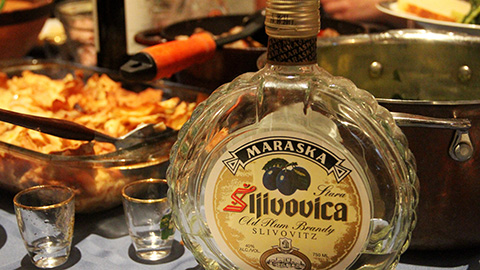
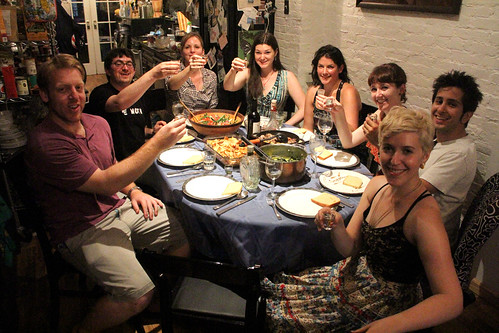
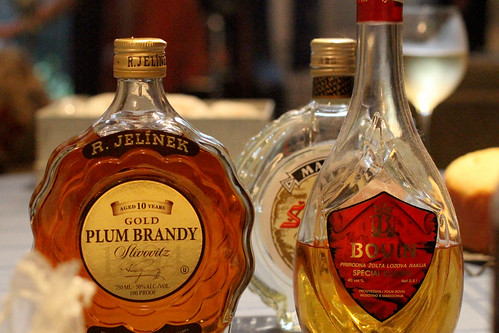

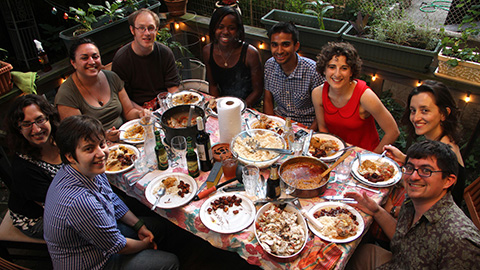






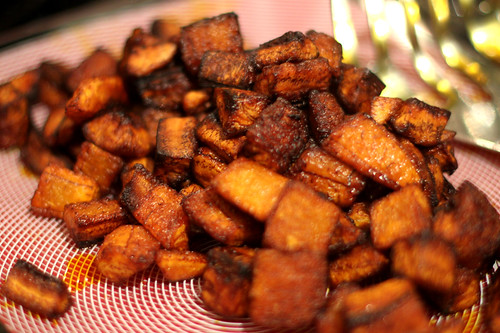
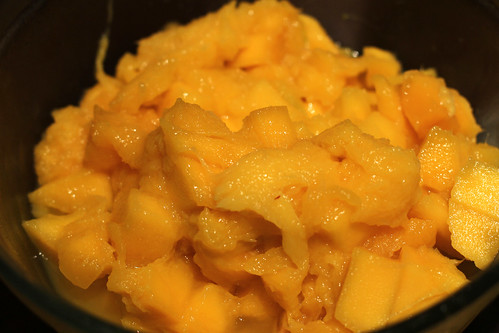
 The larger better-known of the two countries named after the Congo River is the Democratic Republic of Congo, the former Zaire and previously a Belgian colony, but that shows up in the D's. This meal is from the north side of the river, the Republic of Congo, the former French colony, sometimes known as Congo-Brazzaville after its capital.
The larger better-known of the two countries named after the Congo River is the Democratic Republic of Congo, the former Zaire and previously a Belgian colony, but that shows up in the D's. This meal is from the north side of the river, the Republic of Congo, the former French colony, sometimes known as Congo-Brazzaville after its capital.